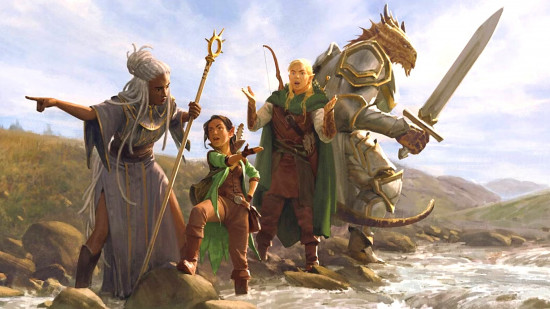Any DM who’s tried to manage a party of seven or more players at once is probably aware that it’s no easy task. So you might be surprised to learn that in the first edition of DnD, Gary Gygax and Dave Arneson suggested “four to fifty players can be handled in any single campaign”.
It strains our imaginations just trying to picture a game with 50 participants. Even with more than five or six players, managing the spotlight can get real tricky, while combat can become a slog.
At least in Gygax’s time, there wasn’t a danger of someone getting distracted by a smartphone, but it’s still hard to imagine how a megagame-scale game with the first DnD edition could have worked. For one thing, how was there enough seating?
The received wisdom is that Gygax and co didn’t generally play DnD in mammoth-sized groups. Instead it was what many now might know as a West Marches style campaign. Instead of a regular, fixed group of characters, the adventuring party was made up of whoever showed up that day, and multiple parties delved into the same dungeon, facing shared foes and even competing for treasure.
It’s possible that this was what Gygax and Arneson meant by handling 50 players in one DnD campaign: a larger pool of PCs that you cold draw different smaller parties out of. But OG DnD rules, plus the game’s first draft – published for the first time in upcoming DnD book, The Making of Original D&D – seems to imply a very high numbers of characters in play.
For instance, Vol 3 of Original D&D, Underworld and Wilderness Adventures, introduces a role of ‘caller’, whose job is to make exploration decisions for the whole party, speeding up play.
Then there’s the fact that Men & Magic (Vol 1) suggests a ratio of one referee (i.e. DM) per 20 players, and the game’s first draft states more referees “are possibly helpful in cases where there are many participants”.
It’s not exactly clear, but rather than having two DMs at the table at once, this could just mean that if you have 40 people wanting to get a game in, you may want to split the load separately between two co-DMs, for your schedule’s sake. This seems to be how the original Castle Greyhawk campaign was played, with Gygax sharing players, and dungeon-building responsibilities, with his co-DM Rob Kuntz.
Finally, there’s the DnD monster numbers. Monsters & Treasure (Vol 2 of Original D&D) suggests goblins or elves appear in groups of 40 – 400, an absolutely mind-boggling quantity. Men & Magic suggests players will want to raise armies, which could account for the high numbers (and also reveals the game’s wargaming routes) but again, it’s not exactly obvious.
I found this section on ‘Number of Wandering Monsters Appearing’ in Vol 3 OD&D particularly elucidating:
“A party of 1-3 would draw the basic number of monsters, 4-6 would bring about twice as many, and so on.” This suggests a default party size similar to modern groups, but “and so on” doesn’t exactly imply an upper limit.
And then, in the very next paragraph, the writers muse about logistics when the game’s rules dictate there should be a ton of monsters, presumably because there are an equally enormous number of PCs, plus their henchmen. “There can be places where 300 Hobgoblins dwell, but how many can come abreast down a typical passage in the dungeons?”
To me, it looks like DnD’s creators designed their tabletop RPG to scale. DnD’s design seems to support a very high number of characters – be they NPCs or PCs – or a very low.
For more content, check out our great guides to DnD classes and DnD races.
Source: Wargamer




